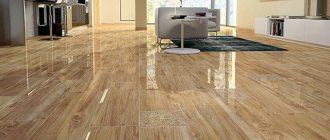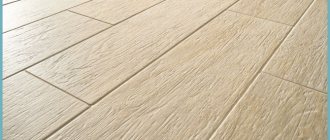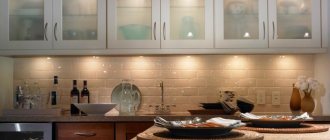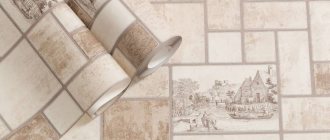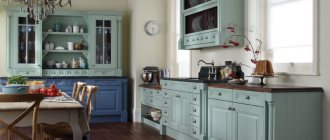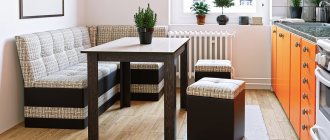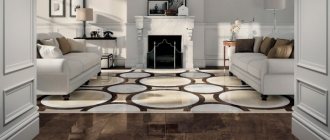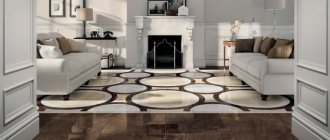Specifics of porcelain stoneware, its advantages
Porcelain tiles are included in the category of ceramic finishing materials. But it has certain differences from traditional tiles. The structure of these types of finishes is similar, however, the production technology of porcelain stoneware is specific. Its production involves pressing and firing at elevated temperatures. These operations ensure solidity and absence of pores. The material is durable; moisture practically does not penetrate into it, even if the porcelain stoneware is in water.
Porcelain tiles are durable
The high density and homogeneity of the material makes it resistant to mechanical stress. These tiles do not chip, and contact with a sharp object does not leave scratches. In addition, porcelain tiles:
- does not lose properties under ultraviolet rays;
- completely retains the structure during temperature changes;
- inert to chemicals.
These properties guarantee the finish a long service life. You can lay porcelain tiles on the kitchen floor without hesitation, without fear of damage to the coating from regular washing, accidental falling of heavy objects, or the use of household chemicals.
Porcelain tiles guarantee a long service life for the finish
The use of porcelain stoneware in the kitchen interior
The kitchen can be considered one of the most complex rooms in the house. The choice of materials for it requires a careful approach. Using a finish that is not able to withstand difficult tests will cause a premature loss of attractiveness and the need to make repairs again soon. Porcelain tiles eliminate such problems. This material is ideal for such conditions.
Durable, durable porcelain tiles are ideal for kitchen floors. The coating will fully retain its qualities when:
- regular washing using chemicals;
- falling heavy objects;
- contact with hot water, fat;
- exposure to direct sunlight.
Porcelain tiles retain their qualities when exposed to hot water and grease.
The material does not allow moisture to pass through. Even if, if the plumbing equipment is damaged or for other reasons, water spills on the floor, this will not cause claims from the neighbors below.
The range of these tiles is extensive. You can choose porcelain stoneware for the kitchen floor and walls, and buy an original, reliable sink made from this material. The variety of tile decor makes it possible to choose options to implement any design idea.
A variety of decor makes it possible to choose tiles to suit any interior
An important advantage of the material is its environmental friendliness. It contains no ingredients that can cause harm to health. You can use porcelain tiles for the kitchen floor if people prone to allergic reactions live in the house. This coating does not pose any danger to them. The material contains kaolin clay, quartz powder, mineral pigments, and metal oxides. These are natural ingredients that are safe for humans and animals.
Laying porcelain tiles
Pre-level the base for the tiles if the unevenness is large. You can do this with a cement-sand or self-leveling screed, or level the floor with cement-bonded particle boards. Before installation, the floor is cleared of debris and dust.
Decide in advance what the porcelain tile floor will be like in the kitchen. There are many options: regular layout, offset, diagonal installation, mosaic carpet, combination. For a regular layout, you can start from the threshold of the kitchen and dining area so that the cut tiles are hidden under the kitchen furniture. To form a ceramic carpet, first find its intended center on the floor, and install it from the central point in both directions.
Required tools:
- tile cutter;
- drill with a nozzle for diluting glue;
- glue container;
- roulette;
- notched spatula;
- rubber spatula;
- rubber hammer;
- building level;
- crosses for forming seams.
Procedure for laying porcelain tiles
- Dilute the adhesive according to the instructions on the package. Let stand for the specified time.
- Apply the adhesive with a notched trowel to a small area of the floor, level the layer and lay the tiles, lightly pressing them into the mortar. Check with a level that the surface is horizontal in two directions.
- Lay a second tile nearby, forming a seam of the required width with crosses. If a rectified material is installed, there is no need to leave seams. Check the level again. You can hit the tiles with a rubber hammer.
- Continue installation in the same way until the entire floor is covered. If necessary, cut the tiles with a tile cutter after carefully measuring the floor area. Don't forget to constantly monitor the level.
- Wait for the adhesive composition to gain strength (the recommended time is indicated on the packaging). Then start grouting the joints. Water-based grout can be tinted to the desired shade. Apply it to the seams and level it with a rubber spatula. After the composition begins to dry, remove the excess with a soft, damp cloth.
The grout can be easily removed from a smooth finish after a few hours, but on a structured surface it is better to remove the excess earlier. The color of the grout can match the tile or be contrasting. After drying, the porcelain stoneware floor can be easily washed with water, and it is better to start using household chemicals after a couple of weeks.
Careful execution of porcelain tile installation operations will allow you to get a beautiful, smooth kitchen floor surface and enjoy its appearance for a lifetime. With it, neither floods, nor falling dishes, nor spilled greasy water are scary. You can change the design of furniture or walls many times, but the floor will always look perfect.
Share the material with your friends on social networks:
Types of porcelain stoneware tiles
Each manufacturer of this finishing material produces a wide range of products, providing consumers with a good choice. You can purchase porcelain tiles for flooring in the kitchen, bathroom, toilet, hall, for wall cladding, for facades, and landscape decoration.
If you need to create an original, interesting interior, this tile will provide invaluable help. The variety of shapes, colors, textures is almost limitless. You can choose porcelain tiles for the kitchen floor or for wall decoration:
- smooth or embossed;
- plain, with ornaments, patterns, “wood”, “stone”;
- matte or polished;
- plain or interspersed with shells and stones;
- standard or large sizes.
The variety of porcelain tiles for the kitchen is almost limitless
In such an assortment, it is easy to find the best option for a specific interior, to provide it with uniqueness and originality.
Combination and styling options
Choosing ceramic tiles for the kitchen floor
Tile laying is done in several variations. At the same time, the diversity of the tiles themselves provides endless possibilities for imagination. Basic installation options:
- Chess board. Traditional and common option. Involves the use of two tile colors. Most often these are contrasting colors. The most popular combinations are black and white, black and red, white and red, beige and brown, gray and white or black, etc.
- Laying diagonally. Involves the use of square tiles.
- Offset by half size. It is possible to use both square and rectangular tiles.
- Herringbone. Externally similar to parquet. Rectangular tiles are used. Porcelain tiles with a wood pattern look the most expressive.
- Modular grid. Using tiles of the same color in different shades.
- Mosaic made from tiles of the same or different sizes. The color and texture may also differ. Both traditional and diagonal masonry are used.
- Traditional installation using small tiles laid diagonally.
The kitchen is a great place to experiment. It should not only be comfortable and tasty, but also interesting and not boring. Thus, a floor tile pattern can be laid out in the form of a carpet, ornate patterns, ornaments, and even paintings with all kinds of images. It all depends on imagination and possibilities.
Porcelain tiles in the kitchen interior
The modern assortment offers many finishing options and designs made from this material. Elements of the kitchen interior can be:
- floor coverings;
- wall covering;
- apron;
- washing.
Porcelain tiles for the kitchen floor are selected taking into account the style of the interior. You can choose tiles with geometric patterns, plain materials for decoration in modern directions, give the proper elegance to the classics with the help of coatings that imitate natural stone, or create coziness with porcelain tiles “like wood”.
Porcelain tiles for the kitchen floor are selected taking into account the style of the interior
When choosing porcelain tiles for kitchen walls, you need to focus on the shades of the furniture to ensure harmony. In modern styles, glossy materials look good, matte finishes look noble, aristocratic, and correspond to classical canons. A porcelain stoneware backsplash can be an accent or part of the background. The choice depends on the specifics of the interior.
Porcelain tiles for kitchen walls look noble and aristocratic
Porcelain stoneware began to be used in the manufacture of kitchen sinks relatively recently. But such products have already been appreciated by many consumers. The high strength of the material guarantees the product a long service life. The sink is easy to care for, any dirt can be easily removed from it, and the surface looks perfect after a simple wash. An extensive palette of shades ensures the ideal choice of model.
Kitchen sink made of porcelain stoneware
Any of the above options is perfect for decorating a kitchen interior. However, it should be taken into account that the abundance of porcelain stoneware can make the atmosphere too cold, which is unacceptable for this room. It should be not only beautiful, but also cozy. You can view photos of porcelain tiles in the kitchen and select project options developed by professional designers.
Design of floors in the kitchen and hallway made of porcelain stoneware
The design of the floor in the hallway made of porcelain stoneware, as in the kitchen, should be developed taking into account the technical and visual characteristics. Tiles can either increase or decrease space, add shine or add confusion to the overall picture.Porcelain stoneware floor panels: layout options and manufacturers
Designer tips for choosing flooring:
- White porcelain tiles for the floor visually increase the area of the room.
- If it is necessary to raise the ceilings and expand the kitchen, you should use the original masonry method (herringbone, diamond, staggered, diagonally, ladder).
- Dark tiles are installed in large rooms, light tiles in small ones.
- Shiny surfaces are suitable for small spaces.
- Porcelain tiles are laid instead of baseboards.
- Large slabs are not recommended for use in small rooms; they narrow the volume of the floor.
- Wood-look tiles blend seamlessly with parquet boards and laminate flooring.
- The combination of floor coverings works for zoning, separating the dining area or hall space from the cooking area, in the case of the kitchen, and from the entrance - from the corridor.
- Combining floors is most important in elongated rooms, which thus expand, and with the help of additional curves and straight lines, monotony is lost.
- When laying tiles in large rooms, it is recommended to introduce additional nuances of color and shape by placing tile panels in the center, using several types of facing material, and performing mosaic edging.
- Matching or bringing tiles closer to the color of floor coverings in other rooms allows you to achieve harmony. The most advantageous options: beige porcelain tiles and brown laminate, red porcelain tiles for the floor and brown boards, brown tiles and linoleum of the same color.
- Contrast allows you to achieve originality. Gray porcelain tiles for the floor with red, black tiles with white. Modern design requires accents and unusual combinations.
- Large tiles with a three-dimensional pattern visually increase the space, and light colors and a smooth surface only enhance this effect.
- Black and green porcelain floor tiles absorb light well, but even the slightest damage and scratches are visible on them.
- A cozy atmosphere is created by surfaces of warm colors and textures.
- It is recommended to cover the front part of the hallway and the work area in the kitchen with the most durable tiles that are resistant to mechanical and chemical attack.
Porcelain tiles are the most practical choice for the kitchen and living room, where the floors are constantly exposed to aggressive influences. Modern tiles look elegant and appropriate, visually adding value to the interior. At the same time, it does not lose its original aesthetics for a long time and for many years it looks as if it was just laid on the floor yesterday.
Material classification
An important property of the finishing material is abrasion resistance. There are several types of coatings in the range of porcelain tiles. They differ in the ratio of components that provide functional indicators that determine the purpose of the products. In the category of porcelain tiles there are 5 classes, the material is selected depending on the degree of load:
- low – grades 1 and 2;
- secondary – 3rd grade;
- high – 4th grade;
- advanced – 5th grade.
Porcelain tiles for the kitchen are selected depending on the degree of load
Class 4 and 5 tiles are used in the design of public facilities and industrial buildings. These materials can withstand the loads of a large flow of people and vehicles. If you need to clad walls, coatings of classes 1 and 2 will be the best choice. Porcelain tiles for kitchen floors should have higher strength and abrasion resistance. An excellent option for such finishing is class 3 material.
Porcelain tiles for kitchen floors must have high strength
Features of choice
Buying porcelain tiles involves some difficulties when choosing the appropriate option. You should pay attention not only to external data, but also to technical characteristics.
- Strength. For the kitchen, the best option would be porcelain tiles with a wear resistance rating of at least 3.
- Back side. On the other side of the tile, a certain pattern should be visible: squares with edges no more than 2 cm and recesses no more than 0.3 cm.
- Caliber. This indicator must be looked for on the packaging of the material. The caliber scale looks like this: 0.6; 0.7; 0.8; 0.9; 0; 0.1; 0.2. Tiles should be selected with adjacent calibers, for example, 0.8 and 0.9 or 0.1 and 0.2.
- No defects. It is necessary to carefully check the porcelain tiles for any defects, chips, cracks, uneven edges, etc. It is advisable if each tile is inspected individually.
- Company `s logo. The manufacturer's imprint should be visible on the back of the tile.
In addition, the following signs can be found on the packaging: foot, palm, foot on a painted surface, flame, etc.
- “Foot” indicates that porcelain stoneware belongs to floor coverings.
- “Palm” - tiles suitable for walls.
- “Foot on a painted surface” – the material has increased strength.
- “Flame” with numbers 1 or 2 – the number of tile firings.
Two signs shown side by side mean that the floor covering has this quality to a double degree.
Porcelain tiles also have a wide selection of different colors and textures. This opens up great opportunities in kitchen interior design. Among the surface decor we can highlight:
- Monocolor. This is a plain option with a matte or glossy surface. Natural pigments are used to color the tiles. When decorating the kitchen floor, you can use tiles of the same color or combine several shades to create a bright, unusual interior.
- Granite. The tiles are stylized as granite stone. This material has a high price, as it involves a rather complex manufacturing and painting process.
- Salt and pepper. This is a single-color tile with small speckles and a wide choice of shades. It is one of the most affordable.
- Textures. Porcelain tile coatings imitate various surfaces and materials: wood, stone. There are also options with abstract patterns and ornaments applied to the tiles.
- Marble. The material imitates a marble floor. One of the most expensive types of porcelain stoneware.
A porcelain tile floor with a glossy surface looks stylish and impressive, but in the kitchen it is better to avoid this option. Since the material does not absorb moisture, any spilled liquid will remain on the surface, and this, combined with gloss, increases the chances of slipping. It is better to opt for matte porcelain tiles.
The most popular types of tiles
The choice of material for finishing walls and floors sometimes causes certain difficulties. A large assortment becomes not a help, but a hindrance, making it difficult to decide, to understand which option will ideally decorate the interior, make it more expressive and attractive. The porcelain tile category has a popularity rating that can serve as a guide when purchasing.
The most popular tiles are:
- "salt and pepper";
- imitation of natural stones;
- with abstraction;
- "under the tree".
A single-color porcelain tile with small white specks is called “salt and pepper.” Its popularity is due to the versatility of the material. It fits well into any interior. Stains and dirt are practically invisible on this coating.
Salt and pepper porcelain tiles
Imitation of marble, granite, and other natural stones is the ideal solution if you need to give the interior a solid, respectable look. Abstraction tiles are preferred by lovers of original, extraordinary interiors. Wood-like coverings create a feeling of comfort and warmth.
Porcelain tiles with marble imitation
In wall cladding you can use materials with ornaments and patterns. This decoration will provide comfort and give the room a cheerful mood.
Porcelain tiles with ornaments will make the interior more comfortable
Combinations in the interior
To choose the right room design, you need to adhere to the following rules:
- Carefully consider the interior design and calculate the number of tiles.
- Ceramic finishing of walls, splashbacks and floors should be in harmony with the kitchen set, curtains and furniture. The shade of the baseboard and border is of no small importance. Such combinations need to be thought through very carefully.
- When used in contrast, it should not be irritating or distracting. It is important to observe the principles of moderation.
- The flooring, cabinets and backsplash should all coordinate with each other. The tiles can match the color of the countertop.
Even when choosing bright and contrasting tiles for the kitchen, they should fit into the overall style of the room.
The tiles should fit organically into the interior
Types of porcelain stoneware textures
Several processing technologies are used in the production of porcelain stoneware. The variety of surface textures is one of the guarantees of an excellent choice of material, taking into account the specific purpose. Porcelain tiles are:
- technical,
- matte,
- polished,
- polished,
- satin,
- embossed,
- glazed,
- structured.
The technical material is cheap, but highly practical. It is not inferior in strength to granite. Matte tiles have a low price due to the lack of processing. The aesthetic characteristics of the coating are good. Polishing provides the material with a mirror shine. But this treatment reduces strength. You can use such porcelain tiles for kitchen walls. Polished tiles also have shine. It is not intended for use in harsh environments.
Glossy porcelain tiles on the kitchen floor
Satin porcelain tiles have a noble shine, high strength and abrasion resistance. Since the compounds that add shine are applied before firing, all the technological properties of the tile are completely preserved. The relief coating perfectly imitates natural stone. These materials are often used in the design of facades, plinths, and fireplaces.
Wall cladding is often done with glazed tiles. These porcelain tiles are available in a wide variety of textures and a wide range of colors, allowing you to choose the perfect finish. But you need to take into account that under high loads the paint layer can wear off. The material should not be used as a floor covering. Structured porcelain tiles are perfect for kitchen floors. The material can imitate wood, stone, and has a non-slip surface, which is important for safety.
Glazed tiles in kitchen decoration
Types of porcelain stoneware
To find your way around porcelain tiles for the kitchen, you need to consider the available options:
- Technical is used for summer kitchens and unheated rooms. He is inferior to the others in appearance. This is a durable and reliable material.
- Polished gloss is not used in the work area, as it slips a lot when in contact with liquid. Due to the polishing procedure, the structure of the material changes, porosity increases, which reduces the functional characteristics. Mirror polished floors visually increase the space of kitchens.
- Matte porcelain tile has a texture with a surface similar to stone, does not slip or wear off. High pressure pressing technology is used in production. The surface does not undergo additional processing. The simple design is popular in high traffic areas.
- Matte with double pressing - used for large areas and has an expressive texture with a pattern. When the top layer is erased, the design disappears. In a kitchen environment, the coating will last for decades without losing its original appearance.
- Structured or textured is good for kitchens, non-slip, stone or wood textured. There are samples that imitate leather, stone mosaics, or have simple patterns. The floor covering looks beautiful, but is difficult to clean due to its textured surface. Samples with anti-slip coating are suitable for the kitchen.
- Lapped consists of glossy and matte strips, reducing discomfort when using polished tiles. The surface is covered with fine relief, perfect for use in kitchens.
- Satin has a shiny velvety surface, practically does not slip and looks impressive in design. The beautiful effect is obtained due to the application of mineral salts with different melting points.
- Relief has a structure similar to natural stone. Its surface is uneven with roughness.
- Glazed is covered with natural glaze, which helps create the material in different shades and textures. The glaze imitates parquet and wood floors well. It wears out over time, making it suitable for low-traffic areas.
- Sanded has the same shine as polished material, but has reduced performance characteristics and less strength.
- The untreated one has a matte surface with roughness. Suitable for areas where slipping is prohibited. This is a durable, moisture-resistant material.
Porcelain tiles in designer styles
When choosing any finish, the fundamental guideline is the style of the room. A large assortment of porcelain tiles for kitchen walls and floors makes it possible to find the right options. The collections of well-known manufacturers contain materials for all popular trends, universal coatings that can be used in several styles. Porcelain tiles look harmonious in:
- classics,
- country,
- Provence,
- hi-tech,
- minimalism,
- loft,
- modern,
- art deco, etc.
Porcelain tiles are suitable for all popular interior styles
In classic designs, preference is given to materials “granite” and “marble”. These coverings create an excellent background for furniture sets made of wood with carvings and give the kitchen a presentable, majestic look.
Now manufacturers offer porcelain tiles that perfectly imitate parquet or solid boards. The ability of wood to create perfect coziness is undeniable. But it is irrational to use this material in kitchen decoration. In the difficult conditions of this room, it will quickly begin to collapse. You can lay porcelain tiles on the kitchen floor, provide the required comfort and easy maintenance, and eliminate the risk of premature damage. Wood imitations look good in different styles; such coatings fit especially well into country and Provence.
Porcelain tiles imitating boards
Modern designs use monochromatic options, glossy materials, and abstract tiles. The right choice allows you to make competent interior corrections. If there are enough bright accents, a plain finish will provide the required conciseness. Glossy tiles will add a touch of chic to the interior and eliminate facelessness. On the kitchen floor, abstract porcelain tiles can be the perfect accent in a too restrained design.
Porcelain tiles with abstraction can be the perfect accent
Porcelain tiles in the kitchen
Porcelain tiles for the floor - selection criteria
Stylish porcelain stoneware floor
The kitchen is perhaps the most visited room in any house or apartment. It is in this room that all family members gather at least twice a day.
Many residential buildings do not have enough space for kitchens, so the flooring in these rooms is subject to the greatest impact, as well as excessive loads.
When carrying out regular renovations, many people are wondering what flooring to choose for the kitchen so that its service life is as long as possible.
After all, from their own experience, most people know that it is necessary to renew the flooring in a room such as a kitchen, due to the fact that it partially or completely fails, on average once every 7 years. And increasingly, porcelain stoneware tiles for the kitchen are chosen as such a covering.
Before making a choice of what kind of flooring will be in the kitchen, it is worth deciding what criteria will be taken as the basis for this choice. And why exactly porcelain tiles in the kitchen will meet all these criteria.
Some people want the floor to be beautiful and attractive, while others want to have a durable and wear-resistant floor. If there are small children in the family, then they give preference to floor coverings that have high antibacterial properties, and also to ensure that the floors are warm.
People who put practicality and rationality first most often identify the following main criteria for themselves when choosing flooring for the kitchen:
- First of all, the flooring should be beautiful, attractive and pleasing to the eye.
- The flooring material must have very high wear resistance. To delay the next repair for as long as possible or until you get tired of it.
- The material from which the floor covering is made must have very high strength. Because in the kitchen something heavy might fall off the stove.
- The floor must be safe, in particular non-slip and level.
- The floor surface in the kitchen must have increased moisture resistance. That is, do not absorb water and do not create conditions for rotting.
- Antibacterial properties are also present in the main criteria for choosing the material that will be laid on the floor.
- The possibility of combination with the “warm floors” system will be very important.
Porcelain tiles and heated floors
Taking into account all the above qualities, practical and rationally thinking owners choose tiles for the kitchen as flooring. With the wide range of porcelain tiles offered in stores, it is possible to satisfy almost any surface.
It's a small matter: choosing a kitchen design and determining the color and texture of porcelain tiles and tiles for the kitchen.
Attention: When laying porcelain tiles with your own hands, periodically check the surface using a building level. This is done in order to prevent differences in height. You can get rid of differences by adding glue or vice versa, by gently tapping with a rubber mallet. And, of course, the instructions for laying tiles should be carefully studied.
Check the surface with a level
Finishing kitchen walls with porcelain stoneware
Walls in porcelain stoneware
As already mentioned, porcelain tiles are used when it is necessary to obtain a coating that is sufficiently durable. When making a kitchen apron, there is no point in using porcelain tiles, because working with them is more difficult, and the price is higher. In the kitchen, it is more rational to use it as cladding for part of a wall, columns or fireplace.
When decorating walls with porcelain tiles, it is worth remembering that it is not cement that is used, but a special adhesive solution that has plasticizing additives. The fact is that porcelain stoneware is a non-porous material and the cement solution is not able to provide the necessary adhesion.
When installing porcelain tiles, you should pay attention to the base so that it is smooth, there is no paint on it, so that there is no lime mortar or gypsum. Because of this, the tile will adhere less well to the surface.
Porcelain tiles in unique interiors
The vast assortment of porcelain tiles makes it possible not only to choose the right material for a specific interior, but also to create unique designs. Nowadays, extraordinary, interesting solutions are in fashion. This tile provides the opportunity to implement the most complex projects.
Using porcelain tiles for the kitchen floor or walls, you can:
- lay out unique ornaments;
- apply patterned coatings;
- create panels in patchwork style;
- cover the surface with hexagonal elements;
- use a combination of materials.
Bright apron in patchwork style
The variety of shades makes it possible to create ornaments according to your own design, focusing on the design style and basic shades. Ethnic options perfectly decorate the kitchen interior, give it originality, and are suitable for styles: eco, rustic, country, Scandinavian.
In this category there are tiles with patterns in floral and plant themes. A photo of porcelain tiles in the kitchen allows you to verify the attractiveness of the design. This interior is characterized by maximum comfort, lifts your spirits, and allows you to enjoy the atmosphere of a warm home.
Contrasting decor will lift your spirits
Patchwork style is widely used in modern fashion. A panel in the form of a patchwork quilt made of plain, patterned elements will perfectly decorate one of the walls and become the main accent of the interior.
The designs made with tiles having a hexagonal configuration look interesting. With its help, expressive 3D effects are created and the atmosphere is given an extraordinary, futuristic character.
Floor decor made with hexagonal tiles
One of the advantages of this material is its excellent compatibility. Porcelain tiles for kitchen floors can be combined with wood, laminate, and linoleum. This technique will help if you want to create an original interior according to an exclusive project.
How to choose
After weighing all the pros and cons, we decided to put porcelain tiles on the floor in the kitchen and hallway. And here new questions arise:
- How much material should I purchase? This depends on the surface area on which the tiles will be laid. Its number will be influenced by the size of the tiles, as well as the installation method. Experts advise taking tiles with a reserve (5-15%).
Porcelain stoneware tiles have their own variable range of standard sizes: 15×15, 20×20, 30×30, 30×40, 40×60, 60×60 cm. Square tiles with a side from 20 cm to 60 are very popular. There are other sizes, but they are mainly needed to create a decorative pattern. Both the size and color of the tiles are selected for a specific room. According to the advice of experts and consumer reviews, medium-sized tiles look best in a small kitchen: 30 by 30 cm. Larger ones visually make the room smaller. For large rooms there are no such restrictions.
- How to determine whether porcelain tiles are of high quality? You should consider the back side of the tile. It should have neat holes in the form of squares, each side should not exceed 20 mm, and the depth should not exceed 3 mm. When the technical holes are deeper and have uneven edges, this indicates irregularities in the production cycle.
- What wear resistance should the material for the kitchen and hallway have? There are 5 groups of porcelain stoneware that characterize its wear class: from PEI 1 (for rooms with low traffic) to PEI 5 (for buildings where not only people, but also equipment work). For kitchen floors, class PEI 3 is usually chosen.
- What type of porcelain tiles should you choose for your kitchen floor? Today there is a wide range of tiles made from this material on the market. But not every one is suitable for the kitchen.
Based on reviews on construction forums and recommendations from experts, it is clear that the best choice for the kitchen is practical matte porcelain tiles. It has all the qualities necessary for this room: it does not slip even when wet, is very durable and wear-resistant, and can be easily washed with any means. The same applies to technical porcelain stoneware, but its appearance is not very attractive and the number of colors is minimal. The textured material is also good - it looks beautiful and has good wear resistance. The slight difficulty is that it is more difficult to clean due to the surface texture.
Satin porcelain tiles are very beautiful, have good anti-slip properties, but cannot withstand heavy loads. Very suitable for decoration, for creating floor design elements.
Polished or glazed porcelain tiles are not recommended for the kitchen and hallway. It is quite slippery, the glaze wears off over time, and grains of sand and other debris can leave scratches on it.
Porcelain stoneware sinks
Thanks to the high strength and resistance to any influences that porcelain stoneware is characterized by, a kitchen sink made from this material fulfills its purpose for many years. The specificity of production technology allows you to give products any shape or shade. The range of these devices is huge, satisfying the most demanding consumers. The sinks are different:
- fastening methods;
- sizes;
- forms;
- shades.
There are overhead and mortise models, single-bowl and double-bowl, with a wing. You can choose a product that is round, oval, square, rectangular. All products comply with standards and can be used with various types of faucets.
A porcelain stoneware sink can be ordered in any shape and shade.
Important advantages are provided by the properties that porcelain stoneware has. The kitchen sink will not require tedious maintenance, since dirt can be easily removed from the surface with detergents. This is an environmentally friendly material, it does not absorb odors, and maintains aesthetic characteristics throughout its entire service life.
Installation of porcelain tiles
Porcelain tiles for the kitchen floor are an ideal option for owners who make repairs on their own without involving specialists. Installation of the coating will not cause any difficulties for craftsmen who have worked with tiles. In terms of installation method, these materials are identical.
Before you go shopping for porcelain tiles for the kitchen floor, you need to calculate the required amount of tiles and consumables. Please note that waste cannot be avoided. Errors add about 10% of the total area. When installing porcelain tiles, you will need special glue and grouting agents.
At the preparatory stage, the base is leveled. High-quality installation can only be done on a perfectly flat surface. To achieve this result, depending on the condition of the base, plastering, puttying, and creating a concrete screed are performed.
Laying is carried out only on a perfectly flat surface
You may have to prepare the material itself for installation. If there is a paraffin or wax protective coating on it, it must be removed before placing the porcelain tile on the kitchen floor. Wax is removed with soap solutions, paraffin is scraped off with a spatula.
Installation of the material is carried out as follows:
- markings are applied, a starting point is selected;
- the adhesive composition is prepared;
- the glue is applied in an even layer onto the porcelain tiles with a metal spatula;
- The tile is pressed against the base.
It is worth using special plastic crosses in your work. Thanks to this device, porcelain tiles will be laid on the kitchen floor with equal gaps. Excess adhesive solution must be removed immediately using a damp cloth. The final step is grouting.
Spacers for laying tiles with equal gaps
The rules for laying porcelain tiles for kitchen walls are similar. Provided the right choice of consumables and careful execution of the work, a home craftsman with little experience in facing work will be able to achieve an impeccable result.
The difference between porcelain stoneware and ceramic tiles
Porcelain tiles for the kitchen are made from the same raw materials as regular ceramic tiles. It contains the same clay, kaolin, quartz sand and other materials, but the solution prepared from them undergoes more serious processing. It involves firing at high temperatures and very high pressure.
When processing the material, the temperature in the furnace reaches 1300 degrees, and the pressure – 450 kg/sq.cm.
Due to the high temperature in the oven, production makes it possible to squeeze out the smallest air bubbles from the mass and give the finished product very high mechanical strength.
Thus, from the same raw materials, two materials with different characteristics are obtained - ceramic tiles and porcelain stoneware. Moreover, ceramic tiles for kitchen floors are also used quite often: they are cheaper, but inferior in strength and other properties.
Porcelain tiles are much stronger than ceramic tiles
Advantages
Both regular ceramic and porcelain tiles have a lot in common, including a similar appearance (see also which tile to choose for the kitchen floor).
The material is resistant to high loads and chemical attack
But porcelain tiles for kitchen floors are more suitable, as they have the following unique advantages:
- Resistance to high loads . If heavy objects fall on the floor, porcelain tiles will survive, but kitchen tiles may crack. It is worth remembering that the mechanical strength of the material largely depends on how correctly it is laid. If there are voids underneath, then under very heavy loads chips or cracks may form in such places.
The porcelain stoneware floor in the kitchen is absolutely moisture-proof, which is very important for such a room
Due to its wear resistance, the material will serve you for many years
- Absolutely waterproof. Since such kitchen floor tiles do not contain pores, water is simply not able to penetrate into the material. Therefore, you don’t have to worry that a liquid spilled on the floor or a broken sewer will damage the coating.
The price of porcelain tiles is higher than regular ceramic tiles, but its performance is higher
- Acid resistance . It is in the kitchen that there is the greatest risk of drops (including hot water), organic acids, and cleaning agents getting onto the floor surface. Not only will they not be able to damage the surface, but they will also not leave any marks on it.
It is not so easy to damage porcelain tiles
- High wear resistance . On ceramic tiles, the pattern is applied only to the top layer. And porcelain stoneware for the kitchen floor is like a polished stone, the pattern of which pierces its entire thickness to the base. Therefore, even if small chips or scratches appear on its surface, they will not affect the appearance of the coating.
Minor scratches on the coating will not be noticeable
Flaws
There are few of them, but they still exist. First of all, it is a high price. If the kitchen area is large enough, then tiling the floor will cost a decent amount. Especially when you consider the other disadvantages of this coating.
The cost of the material can hit the family budget hard
Disadvantages include:
- Difficulty in preparation and installation . The floor surface should be perfectly flat, without the slightest depressions or depressions. As mentioned above, if you lay porcelain tiles on the kitchen floor without leveling the base, after a while it will begin to break and crack. Without sufficient experience, it is very difficult to make an even screed with your own hands.
- Cold surface. In hot weather this can be considered an advantage. But for most of the year it will be possible to walk on it only in warm socks or slippers. The installation of a “warm floor” in a screed will lead to an increase in the cost of not only installation work, but also its operation.
In the cold season, you can’t walk barefoot on porcelain tiles
